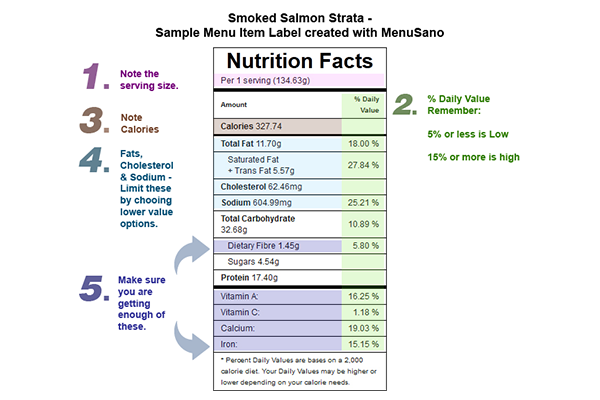Show of hands who wants to know what’s in their food these days? Now show of hands who can understand how to read a nutrition table?
There is an increasing demographic shift towards healthier eating and luckily, since 2005, Health Care Canada requires food manufacturers to provide a nutrition facts table on their packages. Nutrition labels allow us to compare products more easily, find out the nutritional value of foods, manage special diets, and increase or decrease your intake of a particular nutrient – all great things for us. MenuSano provides a similar service but is focused on restaurant meals. MenuSano is a web-based nutrient calculator so that restaurants can provide customers with a nutritional facts label for selected menu items.
However, the labels don’t mean much without some explanation. They are just facts unless you know how to interpret them to make healthier eating choices.
The following is a quick reference guide:
Serving Size
Serving size tells you the amount the food manufacturer has used to calculate the values on the Nutrition Facts Table. Serving size must in be grams (g) or millilitres (mL). It is important to pay attention to the serving size: A food item might say it has 150 calories per serving, but the entire contents might be 4 servings, so you would actually be consuming 600 calories.
Percent Daily Value
% Daily Value is an important one. It tells you if there is a little or a lot of a nutrient in one serving of the food item. The rule of thumb is:
- 5% Daily Value or less is a little
- 5% Daily Value or more is a lot
Nutrients you generally want more of are Calcium, Iron, Fibre, Vitamin A, and Vitamin C. Nutrients you may want less of are fat, saturated and trans fats, and sodium. Note that there is no % Daily value for protein and sugar. Health Canada states this is because most Canadians easily get enough protein. As for sugar, the reason there is no % Daily value is that there is generally no accepted sugar target for a healthy population.
Calories
Calories tell you how much energy you get from one serving of the food item. This is significant because you want to balance how much energy you take in with how much you need to fuel your level of activity.
Fat
The sum here represents a total of all the fats contained in the food item, including saturated and trans fats. Your body makes cholesterol from saturated fats, which can build up and narrow your arteries. Trans fats raise the levels of your bad cholesterol, increasing your risk for heart disease and stroke. There are no safe levels of trans fats. The Heart and Stroke Foundation urges Canadians to limit processed trans fats to as little as 5% Daily Value of your total daily fat intake, or try to avoid it altogether if possible. A healthy eating pattern includes 20% to 35% of your calories from fat. For a woman, this means 45 g to 75 g of fat a day. For a man, this means about 60 g to 105 g per day.
Cholesterol
Cholesterol is a type of fat made by the body, but it is also found in some foods such as animal-based foods, such as cheese, eggs, and meat. It is not found in plant-based foods, such as fruit, grains, and vegetables. According to Health Canada, listing the % Daily Value for cholesterol is optional for food companies. It is important to consider the role of cholesterol created in the body by saturated and trans fats you eat since they all contribute to increasing your risk of heart disease and stroke.
Sodium
Sodium is a mineral that is found in food and table salt. Most of the sodium in our diets is added to foods during processing because it adds flavour and is also used as a preservative. Our bodies need some sodium, but too much sodium may increase blood pressure which is a major risk factor for heart disease, kidney disease, and stroke. Too much sodium may also be a risk factor for stomach cancer.
Carbohydrates
Carbohydrates are the body’s main source of energy. In the Nutrition Facts table, carbohydrates include starches, fibre, and sugar.
Protein
Protein is a compound found in animal products, nuts, and legumes. On a daily basis, it is easy to eat enough protein to keep your body healthy, which is why a % Daily Value is not given for this nutrient. For good health, though, choose lean meats and remove the skin from chicken. Try beans, fish, and soy more often.
Vitamins
Vitamin A – Vitamin a helps keep skin healthy, is an important part of normal bone growth, and may help keep good night vision.
Vitamin C – Vitamin C helps the body absorb iron, heal wounds, and acts as an antioxidant. Fruits and vegetables are the best sources of vitamin C.
Calcium – Calcium is a mineral and is important for the structure of your bones and teeth and helps your muscles work. Calcium can be found in dairy products such as cheese, milk, and yogurt. Furthermore, calcium can be found in dark green vegetables such as broccoli, kale, and spinach.
Iron – Iron is a mineral that helps produce red blood cells and transport oxygen throughout the body.



















